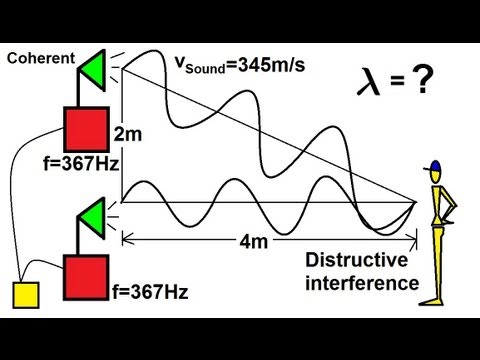Michel van Biezen
Visit http://ilectureonline.com for more math and science lectures!
In this video I will show you how to calculate I=? when there is sound (or wave) interference.
Source

Michel van Biezen
Visit http://ilectureonline.com for more math and science lectures!
In this video I will show you how to calculate I=? when there is sound (or wave) interference.
Source
Comments are closed.
Sir, are the wavelength (λ) for both wave always same?
New subscriber ❤️
Very nice explination
Thank you, professor Michel Van Biezen for provide us practical problems/examples. You're my first source when I want to practice some problems/questions after read the theory.
i would like to know. what is the reference you are using on this topic sir,
thanks.
https://youtu.be/b87QZtYKmqo
Funny, you sound exactly like an American. But your name is completely Dutch. Parents or a further ancestor?
how comes we never experience this ? you never find a spot in a room with two speaker where there's no music..
and also you never find a spot where music get louder.. it sounds the same everywhere in the room
Thank you! Great explanation!
You just saved my assignment mark 😅🙏🏼
i cant wait to pass the exams
If sound intensity is literally 0 W/m^2, does that mean -inf decibels?
Michel, you're my hero
Hi Michael, first of all thank you for your lectures/videos. Just a quick comment. In the snapshot of the video you have a typo: "distructive" instead of "destructive". Thanks!
love this channel helps alot
A really straightforward and easy to understand explanation
is the extra distance called path difference?
Velocity of sound is 332m/s
This is confusing, where is the original question? what is the question asking? you go over this in your video however i would like to see the question written down 🙂
Why not use Vsound= 331m/s
If I have 2 speakers emitting 1250hz, unknown distance apart. And a person stands 12m directly in front of one of them. How would I calculate the distance between speakers so the person would hear no sound? I've been stuck on this problem for awhile now.
so does that mean that it can still be perfectly destructive even if you'd move a bit further away or even closer?
You're video's are great and they really help me practice for my exams, so thank you.
This example, however, has me a bit confused. The intensity of the two waves won't be exactly the same, because one has traveled a greater distance and thus has lost some of it's magnitude – right?
How would I calculate the lowest frequency obtained by the person, if I only have the velocity of sound and the distances of the speakers and to the person, assuming that the frequency on each of the speakers are the same?
Are there any resources that we could practice these questions?
Totally agree with nvrlopyimism! Thanks so much Michel!
Nvrloptimism,
No need to apologize. All comments favorable and unfavorable are welcome. I appreciate the feedback so I can adjust to the needs of the students out there. Your words are encouraging and it has given me great pleasure that thousands of students around the world have been helped by these videos.
Honestly, as much as I like khanacademy, freelance, brightstorm…this professor has by far the best grasp in what high school/college physics students need. I apologize for spamming you with comments here and there but you need way more subscribers, viewers, and public recognition. Please continue to do what you do and hope you know that there are people who sincerely appreciates your content.